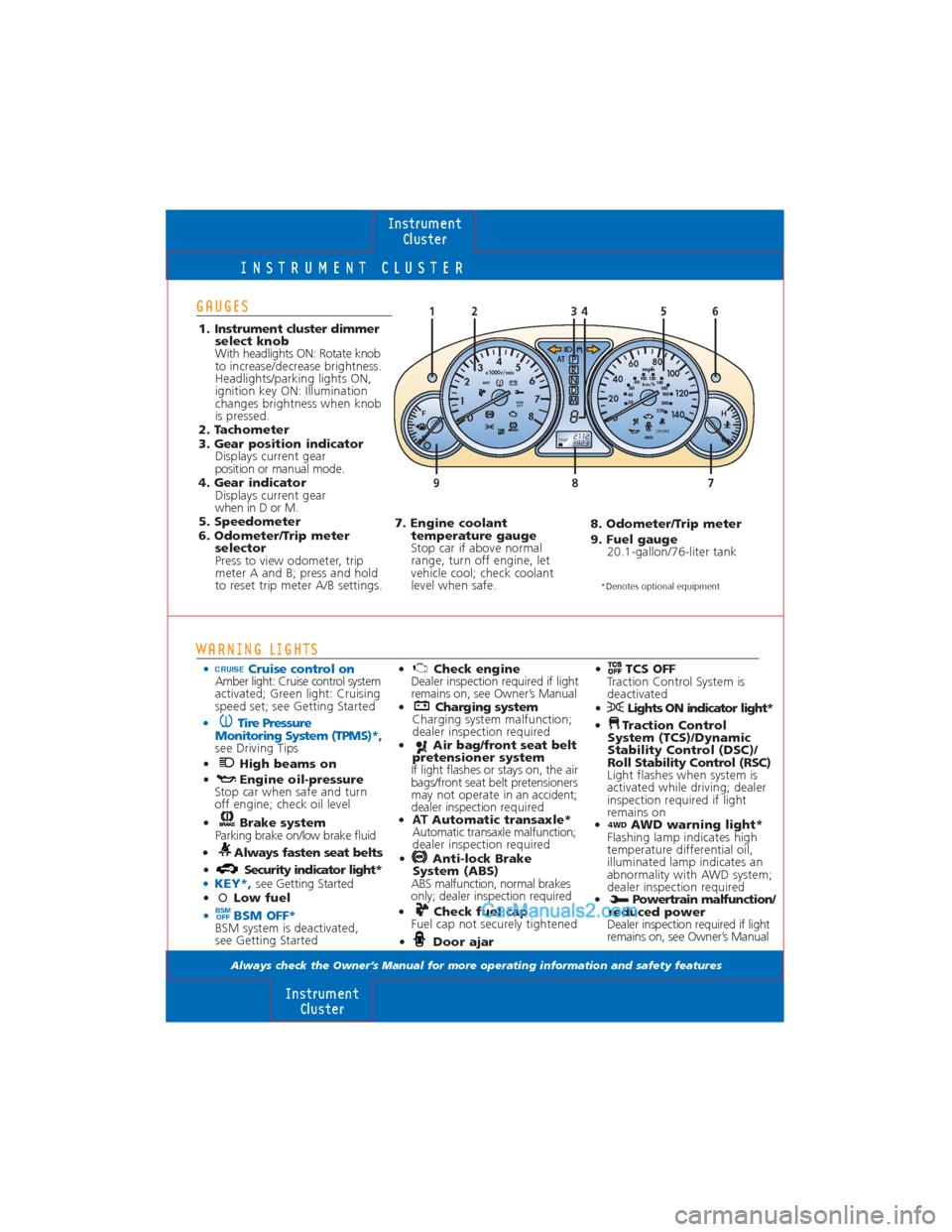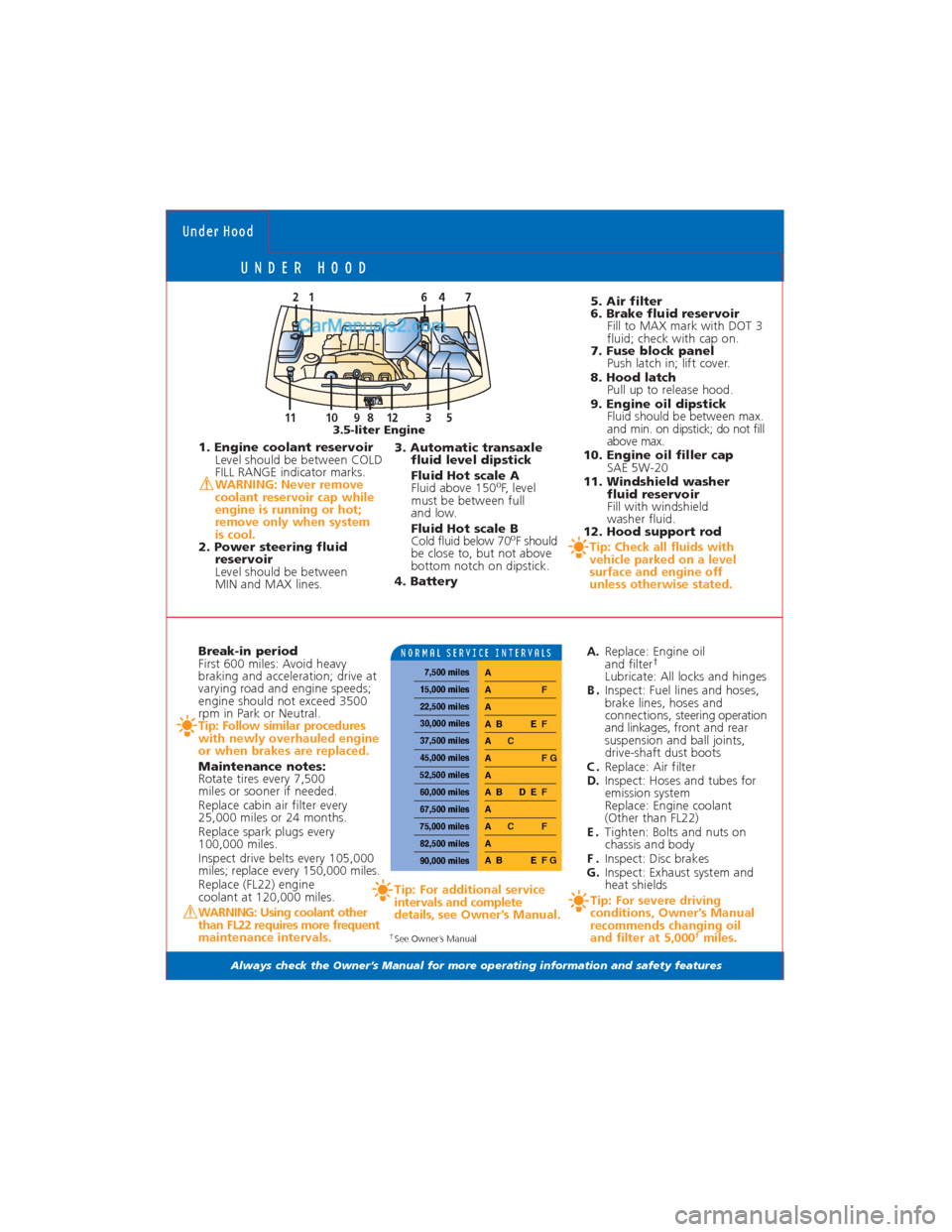engine coolant MAZDA MODEL CX-9 2008 Quick Tips (in English)
[x] Cancel search | Manufacturer: MAZDA, Model Year: 2008, Model line: MODEL CX-9, Model: MAZDA MODEL CX-9 2008Pages: 15, PDF Size: 2.04 MB
Page 6 of 15

INSTRUMENT CLUSTER
Always check the Owner’s Manual for more operating information and safety features
WARNING LIGHTS
• Cruise control onAmber light: Cruise control system
activated; Green light: Cruising
speed set; see Getting Started
• Tire Pressure Monitoring System (TPMS)*,
see Driving Tips
• High beams on • Engine oil-pressure Stop car when safe and turn
off engine; check oil level
• Brake system Parking brake on/low brake fluid
• Always fasten seat belts • Security indicator light*
• KEY*,see Getting Started
• O Low fuel
• BSM OFF*BSM system is deactivated,
see Getting Started
BSM
OFF
GAUGES
1. Instrument cluster dimmer select knob
With headlights ON: Rotate knob
to increase/decrease brightness.
Headlights/parking lights ON,
ignition key ON: Illumination
changes brightness when knob
is pressed.
2. Tachometer
3. Gear position indicator Displays current gear
position or manual mode.
4. Gear indicator Displays current gear
when in D or M.
5. Speedometer
6. Odometer/Trip meter selector
Press to view odometer, trip
meter A and B; press and hold
to reset trip meter A/B settings.
• Check engineDealer inspection required if light
remains on, see Owner’s Manual
• Charging system Charging system malfunction;
dealer inspection required
• Air bag/front seat belt pretensioner system
If light flashes or stays on, the air
bags/front seat belt pretensioners
may not operate in an accident;
dealer inspection r equired
• AT Automatic transaxle*
Automatic transaxle malfunction;
dealer inspection required
• Anti-lock Brake System (ABS)
ABS malfunction, normal brakes
only; dealer inspection required
• Check fuel cap Fuel cap not securely tightened
• Door ajar
7. Engine coolant temperature gauge
Stop car if above normal
range, turn off engine, let
vehicle cool; check coolant
level when safe.
InstrumentCluster
Instrument Cluster
km/h mph
E F H
C
x1000r/min2 3
4
5
6
7
8
TRIP
1 0
0
20 40
60
80
10 0
12 0
140 220
20
40
60
80
100
120
140
160
18 0
200
P
R
N
D
M
8
2112
382.3
8 7 9
4 1 6 2 5
KEY
CRUISE
AT
4WD
3
BSM
OFF
8. Odometer/Trip meter
9. Fuel gauge 20.1-gallon/76-liter tank
CRUISE• TCS OFFTraction Control System is
deactivated
• Lights ON indicator light*
• Traction Control System (TCS)/Dynamic
Stability Control (DSC)/
Roll Stability Control (RSC)
Light flashes when system is
activated while driving; dealer
inspection required if light
remains on
•
4WDAWD warning light*
Flashing lamp indicates high
temperature differential oil,
illuminated lamp indicates an
abnormality with AWD system;
dealer inspection required
• Powertrain malfunction/ reduced power
Dealer inspection required if light
remains on, see Owner’s Manual
*Denotes optional equipment
Page 14 of 15

UNDER HOOD
Always check the Owner’s Manual for more operating information and safety features
Under Hood
1. Engine coolant reservoir
Level should be between COLD
FILL RANGE indicator marks.
WARNING: Never remove
coolant reservoir cap while
engine is running or hot;
remove only when system
is cool.
2. Power steering fluid
reservoir
Level should be between
MIN and MAX lines.
Break-in period
First 600 miles: Avoid heavy
braking and acceleration; drive at
varying road and engine speeds;
engine should not exceed 3500
rpm in Park or Neutral.
Tip: Follow similar procedures
with newly overhauled engine
or when brakes are replaced.
Maintenance notes:
Rotate tires every 7,500
miles or sooner if needed.
Replace cabin air filter every
25,000 miles or 24 months.
Replace spark plugs every
100,000 miles.
Inspect drive belts every 105,000
miles; replace every 150,000 miles.
Replace (FL22) engine
coolant at 120,000 miles.
WARNING: Using coolant other
than FL22 requires more frequent
maintenance intervals.Tip: For additional service
intervals and complete
details, see Owner’s Manual.
3. Automatic transaxle
fluid level dipstick
Fluid Hot scale A
Fluid above 150
oF, level
must be between full
and low.
Fluid Hot scale B
Cold fluid below 70
oF should
be close to, but not above
bottom notch on dipstick.
4. Battery
A.Replace: Engine oil
and filter
†Lubricate: All locks and hinges
B.Inspect: Fuel lines and hoses,
brake lines, hoses and
connections, steering operation
and linkages, front and rear
suspension and ball joints,
drive-shaft dust boots
C.Replace: Air filter
D.Inspect: Hoses and tubes for
emission system
Replace: Engine coolant
(Other than FL22)
E.Tighten: Bolts and nuts on
chassis and body
F.Inspect: Disc brakes
G.Inspect: Exhaust system and
heat shields
Tip: For severe driving
conditions, Owner’s Manual
recommends changing oil
and filter at 5,000
†miles.
5. Air filter
6. Brake fluid reservoir
Fill to MAX mark with DOT 3
fluid; check with cap on.
7. Fuse block panel
Push latch in; lift cover.
8. Hood latch
Pull up to release hood.
9. Engine oil dipstick
Fluid should be between max.
and min. on dipstick; do not fill
above max.
10. Engine oil filler cap
SAE 5W-20
11. Windshield washer
fluid reservoir
Fill with windshield
washer fluid.
12. Hood support rod
Tip: Check all fluids with
vehicle parked on a level
surface and engine off
unless otherwise stated.
1 2 4 7
8 3 12 5 10 9 11
6
3.5-liter Engine
†See Owner’s Manual
NORMAL SERVICE INTERVALS
7,500 miles
15,000 miles
22,500 miles
30,000 miles
37,500 miles
45,000 miles
52,500 miles
60,000 miles
67,500 miles
75,000 miles
82,500 miles
90,000 miles
A BEF G A A
C F
A A
B D E F A A
F G A C A
BEF
A A F A